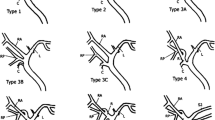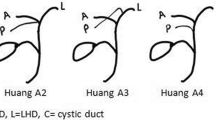Abstract
To evaluate the compatibility of preoperative 3D magnetic resonance cholangiopancreatography (3D MRCP) and intraoperative cholangiographies (IOC) of donors using Huang classification in living donor liver transplantation. Thirty-six consecutive right donor hepatectomy cases were retrospectively analyzed with preoperative MRCP and intraoperative cholangiography. Biliary variants were determined according to the Huang classification. Compatibility in MRCP and IOC was evaluated. 3D MRCP accurately determined the biliary anatomy in 32 of 36 cases (88.88%). The IOC of the 36 donors showed 25 normal bifurcations and 11 biliary variants. For detecting normal and variant anatomy, sensitivity, specificity, PPV, and NPV were 96.0%, 72.7%, 88.9%, and 88.9.0%, respectively. There was a substantial inter-rater agreement between IOC and MRCP in determining normal and variant anatomy (κ = 0.724, p < 0.001). 3D MRCP is a non-invasive useful method to evaluate non-dilated bile ducts preoperatively in living donor liver transplantation. The eligibility criteria determined according to preoperative MRCP images should also be confirmed by intraoperative cholangiography.




Similar content being viewed by others
References
Gamal GH (2017) Minimizing the postoperative biliary complications in living donor liver transplantation, by utility of preoperative non-enhanced magnetic resonance cholangiopancreatography. Egypt J Radiol Nucl Med 2:339–345
Radtke A, Sgourakis G, Sotiropoulos G, Molmenti E, Nadalin S, Schroeder T et al (2009) Vascular and biliary anatomy of the right hilar window: its impact on recipient morbidity and mortality for right graft live donor liver transplantation. World J Surg 33:1941–1951
Kawarada Y, Das BC, Taoka H (2000) Anatomy of the hepatic hilar area: the plate system. J Hepatobiliary Pancreat Surg 7:580–586
Kashyap R, Bozorgzadeh A, Abt P, Tsoulfas G, Maloo M, Sharma R et al (2008) Stratifying risk of biliary complications in adult living donor liver transplantation by magnetic resonance cholangiography. Transplantation 85:1569–1572
Yeh BM, Breiman RS, Taouli B, Qayyum A, Roberts JP, Coakley FV (2004) Biliary tract depiction in living potential liver donors: comparison of conventional MR, mangafodipir trisodium-enhanced excretory MR, and multi-detector row CT cholangiography—initial experience. Radiology 230:645–651
Ragab A, Lopez-Soler RI, Oto A, Testa G (2013) Correlation between 3D-MRCP and intra-operative findings in right liver donors. Hepatobiliary Surg Nutr 2:7–13
Goldman J, Florman S, Varotti G, Gondolesi GE, Gerning A, Fishbein T et al (2003) Noninvasive preoperative evaluation of biliary anatomy in right-lobe living donors with mangafodipir trisodium-enhanced MR cholangiography. Transplant Proc 35:1421–1422
El Hariri M, Riad MM (2019) Intrahepatic bile duct variation: MR cholangiography and implication in hepatobiliary surgery. Egypt j radiol nucl med 50:78
Catalano OA, Singh AH, Uppot RN, Hahn PF, Ferrone CR, Sahani DV (2008) Vascular and biliary variants in the liver: implications for liver surgery. Radiographics 28:359–378
Xu X, Wei X, Ling Q, Wang K, Bao H, Xie H et al (2012) Inaccurate preoperative imaging assessment on biliary anatomy not increases biliary complications after living donor liver transplantation. Eur J Radiol 81:457–460
Yam BL, Siegelman ES (2014) MR imaging of the biliary system. Radiol Clin North Am 52:725–755
Ohgi K, Furukawa T, Akiyama H, Kimura S, Uehara K, Murata K (1998) Basic principles and historical consideration of MR cholangiopancreatography (in Japanese with English abstract). Nihon Rinsho 56:2755–2759
Badger WR, Borgert AJ, Kallies KJ, Kothari SN (2017) Utility of MRCP in clinical decision making of suspected choledocholithiasis: an institutional analysis and literature review. Am J Surg 214:251–255
Hjartarson JH, Hannesson P, Sverrisson I, Blöndal S, Ívarsson B, Björnsson ES (2016) The value of magnetic resonance cholangiopancreatography for the exclusion of choledocholithiasis. Scand J Gastroenterol 51:1249–1256
Limanond P, Raman SS, Ghobrial RM, Busuttil RW, Lu DS (2004) The utility of MRCP in preoperative mapping of biliary anatomy in adult-to-adult living related liver transplant donors. J Magn Reson Imaging 19:209–215
Kim RD, Sakamoto S, Haider MA, Molinari M, Gallinger S, McGilvray ID et al (2005) Role of magnetic resonance cholangiography in assessing biliary anatomy in right lobe living donors. Transplantation 79:1417–1421
Ringe KI, Hartung D, von Falck C, Wacker F, Raatschen HJ (2014) 3D-MRCP for evaluation of intra-and extrahepatic bile ducts: comparison of different acquisition and reconstruction planes. BMC Med Imag 14:1
Griffin N, Charles-Edwards G, Grant LA (2012) Magnetic resonance cholangiopancreatography: the ABC of MRCP. Insights Imag 3:11–21
Basaran C, Agildere AM, Donmez FY, Sevmis S, Budakoglu I, Karakayali H et al (2008) MR cholangiopancreatography with T2-weighted prospective acquisition correction turbo spin-echo sequence of the biliary anatomy of potential living liver transplant donors. AJR Am J Roentgenol 190:1527–1533
Kinner S, Steinweg V, Maderwald S, Radtke A, Sotiropoulos G, Forsting M et al (2014) Comparison of different magnetic resonance cholangiography techniques in living liver donors ıncluding Gd-EOB-DTPA enhanced T1-weighted sequences. PloS One. 9:e113882
Author information
Authors and Affiliations
Corresponding author
Ethics declarations
Conflict of Interest
The authors declare no competing interests.
Additional information
Publisher's Note
Springer Nature remains neutral with regard to jurisdictional claims in published maps and institutional affiliations.
Rights and permissions
About this article
Cite this article
Donmez, R., Gormez, A. Evaluation of the Compatibility of Preoperative MRCP and Intraoperative Cholangiography in Imaging of the Bile Ducts in Living Donor Liver Transplantation. Indian J Surg 84 (Suppl 2), 418–423 (2022). https://doi.org/10.1007/s12262-022-03342-2
Received:
Accepted:
Published:
Issue Date:
DOI: https://doi.org/10.1007/s12262-022-03342-2




